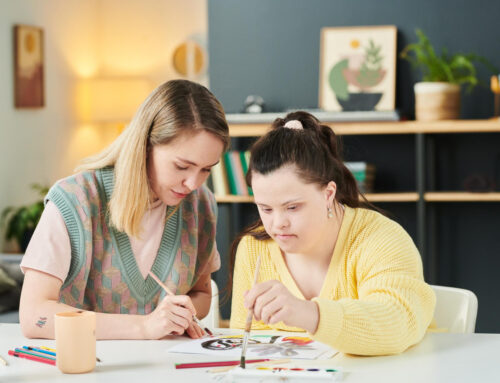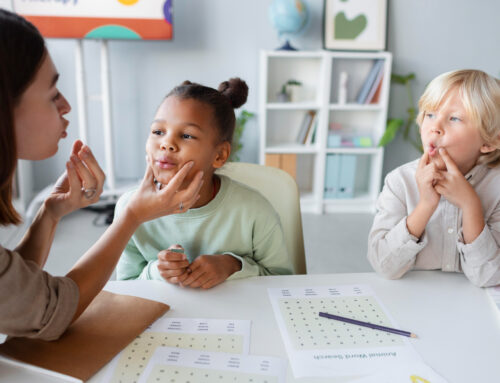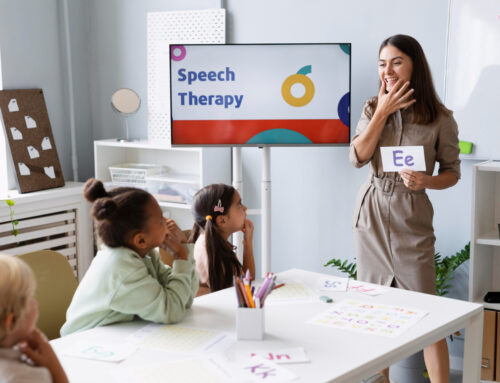Children with Down Syndrome possess unique characteristics that affect their communication & interaction. Speech therapy can present challenges due to the wide range of developmental domains impacted by Down Syndrome.
For instance, there are anatomical & physical differences, such as low muscle tone & a relatively high, narrow palate compared to tongue size.
However, it is important to note that children with Down Syndrome can exhibit a functional vocabulary of gestures & strong receptive language skills.
In general, Down Syndrome characteristics have an impact on communication across six distinct domains:
- Anatomical & physical differences
- Development of hearing
- Cognitive development
- Social & emotional skills
- Motor skills
- Language development
The positive aspect is that by knowing the distinctive advancements in these six domains, we can address particular constraints & still achieve highly effective communication.
The key is to prioritize & leverage a child’s strengths, which are abundant across these six areas.
Anatomical & Physiological Differences
Let’s begin by examining the visible characteristics. Children with Down Syndrome naturally exhibit specific anatomical & physiological variances. Decreased muscle tone in the tongue & cheeks leads to less firm & precise production of speech sounds.
When combined with reduced coordination, it becomes apparent why these children frequently demonstrate diminished intelligibility.
Other common characteristics of Down Syndrome include a significantly narrow & arched palate, enlarged tonsils & adenoids & comparatively small mouth & jaw areas about the size of the tongue.
These physical traits, along with reduced muscle tone, contribute to the challenges faced by children with Down Syndrome in producing specific sounds & sound combinations necessary for clear speech.
We would like to address another concern commonly expressed by parents regarding tongue protrusion. These anatomical differences contribute to a better understanding of this issue.
Additionally, it is important to recognize that the tongue is a muscle that requires contraction. Due to low muscle tone, the tongue may not naturally contract.
Moreover, individuals with Down Syndrome often have smaller airways, leading to an open mouth being their natural resting position for breathing. This positioning is simply more comfortable.
Down Syndrome Characteristics For Hearing Development
In terms of hearing development, children with Down Syndrome commonly experience otitis media with effusion, which is not necessarily an infection but rather the accumulation of fluid behind the eardrum due to anatomical differences, such as a narrower & shorter ear canal.
Consequently, children with Down Syndrome often exhibit fluctuating conductive hearing loss during the initial years of life.
We understand the significance of this developmental phase in communication. As speech pathologists, we must ensure that parents & schools are diligent in conducting hearing screenings, as it can impact our interventions.
It is noteworthy that over 80% of preschool children with Down Syndrome may require tympanostomy (tube placement) in the eardrum to manage otitis media.
For individuals in need of medical treatment, a significant 81% exhibited abnormal hearing before receiving treatment. Therefore, it is quite common to come across children in this population who experience hearing difficulties, necessitating our vigilance in addressing this issue.
Down Syndrome Characteristics With Cognitive Development
In the cognitive domain, children with Down Syndrome demonstrate notable strengths in visual-spatial processing & visual motor skills. Visual tasks encompass block building, line drawing, copying & folding, as well as visual-motor skills involved in using gestures & early communication. These abilities can be considered relative strengths in these children.
Verbal processing presents a notable challenge attributed to specific neurological abnormalities. Both short-term & long-term memory can be significantly impaired, along with difficulties in task engagement & attention span. Research indicates that these behaviours are not solely attributed to a lack of motivation or task complexity.
For instance, when a child with Down Syndrome is not participating in an activity, it may not indicate that the task is excessively challenging. Instead, it could be attributed to the inability to sustain attention caused by a neurological deficit.
We would like to present an illustration of this concept. In our life skills classroom, we usually commence our sessions with a group circle time, which typically lasts around 30 minutes. This duration can be challenging for students to maintain their attention.
For one of our students with Down Syndrome, we have observed that it is beneficial for him to engage in some form of manipulation or have a relevant book at hand that aligns with the academic content we are teaching.
This technique assists him in maintaining engagement & sustaining attention during circle time. Furthermore, teachers have discovered that this approach can be implemented throughout the entirety of the day.
Cognitive Strengths = Visual-Spatial Processing & Visual-Motor Skills.
Social/Emotional Characteristics
In the domain of social/emotional characteristics related to Down Syndrome, these children typically exhibit a strong inclination to engage with others.
Additionally, they have been observed to effectively utilize facial expressions as a means of communication. Research indicates that children with Down Syndrome demonstrate a higher frequency of socially interactive behaviours, including smiling & initiating turn-taking routines, in comparison to their typically developing peers.
However, these children also face challenges in this domain. It has been observed that children with Down Syndrome exhibit delayed reciprocal eye contact during the early stages of development. In comparison to their typically developing peers, their ability to establish & maintain eye contact develops at a slower rate.
However, once this skill is acquired, children with Down Syndrome often maintain high levels of eye contact. Consequently, they may show less interest in exploring their surrounding environment, which can result in missed opportunities to label & request objects.
Therefore, when working with children with Down Syndrome, it is important to consider the triad of joint attention between the speaker, listener & the objects in their environment. It is crucial to ensure that they do not miss out on the world around them.
Social/Emotional Strengths = Desire for Social Interaction, Use of Facial Expressions, Reciprocal Eye Contact, Interest in Exploring Environment When Asked.
Motor Skills Domain
Transitioning to the motor skills domain, noteworthy proficiency is evident in the initial utilization of gestures. Gestures play a pivotal role in the progression of non-verbal communication. The emergence of gestures, like pointing, typically commences at around 12 months, enabling young children to direct others’ attention.
In a separate investigation (Study 1, Study 2), it was discovered that when considering language & age, children with Down Syndrome exhibited a significantly higher frequency of referential pointing gestures compared to typically developing children.
This phenomenon was observed during the prelinguistic phase & early stages of lexical acquisition. This finding is crucial for Down Syndrome language therapy, as it allows us to capitalize on their utilization of gestures to enhance joint attention.
Children with Down Syndrome eventually acquire the motor skills necessary for daily living & personal independence. However, their movements may appear less precise when performing tasks. The characteristic of low muscle tone associated with Down Syndrome likely contributes to delayed motor development, resulting in challenges with balance, posture, strength, flexibility & planning.
As speech pathologists, we recognize the impact of motor planning difficulties on speech. Therefore, it is crucial to facilitate alternate methods of communication to foster the development of these skills.
Down Syndrome Language Development
The final section encompasses the most significant aspect of our work as speech-language pathologists: the language characteristics associated with Down Syndrome. While the preceding five factors hold their own importance & their impact on communication, it is in understanding language communication itself where we find further insight.
As children with Down Syndrome grow older, there is a noticeable trend of greater progress in receptive language skills compared to expressive language development. Not only do comprehension abilities outpace production skills, but this gap widens as chronological age increases.
Research indicates that these children exhibit comparable phoneme production & vocalization time during the early stages. However, children with Down Syndrome may experience slight delays in joint attention & canonical babbling.
Notably, the delay becomes more pronounced in the development of first words. This is often when parents become aware, as they anticipate their children’s initial verbal expressions, which may not occur as expected.
Down Syndrome Language Therapy
Our aim is to equip you with the knowledge to effectively apply this information to the children under your care. In short, there are developmental delays or variations across all domains.
Down Syndrome is prevalent enough for us to have a comprehensive understanding of these variations & incorporate them into our work with these children. This approach leads to greater progress & reduces frustration by providing clear expectations & identifying areas for improvement.
If you’re looking to enhance your Down Syndrome language therapy skills, we have developed a comprehensive course at Theracare Pediatric Services.
In this course, we introduce Total Communication as an effective approach to address the noted differences while ensuring progress. Take a moment & contact us now to learn more about this course & how it can benefit you in your practice.
Let us help you empower these children to reach their full potential!





